*NURSING > QUESTIONS & ANSWERS > SOLVED!!! NR 509 COMPREHENSIVE REVIEW OF JARVIS 7TH EDITION CHAPTER 16 QUESTIONS (Nose, Mouth and Th (All)
SOLVED!!! NR 509 COMPREHENSIVE REVIEW OF JARVIS 7TH EDITION CHAPTER 16 QUESTIONS (Nose, Mouth and Throat: Physical Examination & Health Assessment)
Document Content and Description Below
SOLVED!!! NR 509 COMPREHENSIVE REVIEW OF JARVIS 7TH EDITION CHAPTER 16 QUESTIONS (Nose, Mouth and Throat: Physical Examination & Health Assessment) ◇This material contains comprehensive summary of i... nformation in the form of great test questions with descriptive answers helpful for exams study. Thorough Review of Jarvis 7th Edition Chapter 16 Questions. All the best Champions!!! _____ MULTIPLE CHOICE 1. The primary purpose of the ciliated mucous membrane in the nose is to: a. Warm the inhaled air. b. Filter out dust and bacteria. c. Filter coarse particles from inhaled air. d. Facilitate the movement of air through the nares. ANS: B The nasal hairs filter the coarsest matter from inhaled air, whereas the mucous blanket filters out dust and bacteria. The rich blood supply of the nasal mucosa warms the inhaled air. DIF: Cognitive Level: Remembering (Knowledge) MSC: Client Needs: General REF: p. 353 2. The projections in the nasal cavity that increase the surface area are called the: a. Meatus. b. Septum. c. Turbinates. d. Kiesselbach plexus. ANS: C The lateral walls of each nasal cavity contain three parallel bony projections: the superior, middle, and inferior turbinates. These increase the surface area, making more blood vessels and mucous membrane available to warm, humidify, and filter the inhaled air. DIF: Cognitive Level: Remembering (Knowledge) MSC: Client Needs: General REF: p. 353 3. The nurse is reviewing the development of the newborn infant. Regarding the sinuses, which statement is true in relation to a newborn infant? a. Sphenoid sinuses are full size at birth. b. Maxillary sinuses reach full size after puberty. c. Frontal sinuses are fairly well developed at birth. d. Maxillary and ethmoid sinuses are the only sinuses present at birth. ANS: D Only the maxillary and ethmoid sinuses are present at birth. The sphenoid sinuses are minute at birth and develop after puberty. The frontal sinuses are absent at birth, are fairly well developed at age 7 to 8 years, and reach full size after puberty. DIF: Cognitive Level: Remembering (Knowledge) MSC: Client Needs: General REF: p. 355 4. The tissue that connects the tongue to the floor of the mouth is the: a. Uvula. b. Palate. c. Papillae.d. Frenulum. ANS: D The frenulum is a midline fold of tissue that connects the tongue to the floor of the mouth. The uvula is the free projection hanging down from the middle of the soft palate. The palate is the arching roof of the mouth. Papillae are the rough, bumpy elevations on the tongue’s dorsal surface. DIF: Cognitive Level: Remembering (Knowledge) MSC: Client Needs: General REF: p. 355 5. The salivary gland that is the largest and located in the cheek in front of the ear is the _________ gland. a. Parotid b. Stensen’s c. Sublingual d. Submandibular ANS: A The mouth contains three pairs of salivary glands. The largest, the parotid gland, lies within the cheeks in front of the ear extending from the zygomatic arch down to the angle of the jaw. The Stensen’s duct (not gland) drains the parotid gland onto the buccal mucosa opposite the second molar. The sublingual gland is located within the floor of the mouth under the tongue. The submandibular gland lies beneath the mandible at the angle of the jaw. DIF: Cognitive Level: Remembering (Knowledge) MSC: Client Needs: General REF: p. 356 6. In assessing the tonsils of a 30 year old, the nurse notices that they are involuted, granular in appearance, and appear to have deep crypts. What is correct response to these findings? a. Refer the patient to a throat specialist. b. No response is needed; this appearance is normal for the tonsils. c. Continue with the assessment, looking for any other abnormal findings. d. Obtain a throat culture on the patient for possible streptococcal (strep) infection. ANS: B The tonsils are the same color as the surrounding mucous membrane, although they look more granular and their surface shows deep crypts. Tonsillar tissue enlarges during childhood until puberty and then involutes. DIF: Cognitive Level: Applying (Application) REF: p. 356 MSC: Client Needs: Safe and Effective Care Environment: Management of Care 7. The nurse is obtaining a health history on a 3-month-old infant. During the interview, the mother states, “I think she is getting her first tooth because she has started drooling a lot.” The nurse’s best response would be: a. “You’re right, drooling is usually a sign of the first tooth.” b. “It would be unusual for a 3 month old to be getting her first tooth.” c. “This could be the sign of a problem with the salivary glands.” d. “She is just starting to salivate and hasn’t learned to swallow the saliva.” ANS: DIn the infant, salivation starts at 3 months. The baby will drool for a few months before learning to swallow the saliva. This drooling does not herald the eruption of the first tooth, although many parents think it does. DIF: Cognitive Level: Understanding (Comprehension) MSC: Client Needs: Health Promotion and Maintenance REF: p. 356 8. The nurse is assessing an 80-year-old patient. Which of these findings would be expected for this patient? a. Hypertrophy of the gums b. Increased production of saliva c. Decreased ability to identify odors d. Finer and less prominent nasal hair ANS: C The sense of smell may be reduced because of a decrease in the number of olfactory nerve fibers. Nasal hairs grow coarser and stiffer with aging. The gums may recede with aging, not hypertrophy, and saliva production decreases. DIF: Cognitive Level: Understanding (Comprehension) MSC: Client Needs: Health Promotion and Maintenance REF: p. 357 9. The nurse is performing an oral assessment on a 40-year-old Black patient and notices the presence of a 1 cm, nontender, grayish-white lesion on the left buccal mucosa. Which one of these statements is true? This lesion is: a. Leukoedema and is common in dark-pigmented persons. b. The result of hyperpigmentation and is normal. c. Torus palatinus and would normally be found only in smokers. d. Indicative of cancer and should be immediately tested. ANS: A Leukoedema, a grayish-white benign lesion occurring on the buccal mucosa, is most often observed in Blacks. DIF: Cognitive Level: Understanding (Comprehension) REF: p. 358 MSC: Client Needs: Physiologic Integrity: Physiologic Adaptation 10. While obtaining a health history, a patient tells the nurse that he has frequent nosebleeds and asks the best way to get them to stop. What would be the nurse’s best response? “While sitting up, place a cold compress over your nose.” a. b. “Sit up with your head tilted forward and pinch your nose.” c. “Just allow the bleeding to stop on its own, but don’t blow your nose.” d. “Lie on your back with your head tilted back and pinch your nose.” ANS: B With a nosebleed, the person should sit up with the head tilted forward and pinch the nose between the thumb and forefinger for 5 to 15 minutes. DIF: Cognitive Level: Applying (Application) REF: p. 359 MSC: Client Needs: Physiologic Integrity: Physiologic Adaptation11. A 92-year-old patient has had a stroke. The right side of his face is drooping. The nurse might also suspect which of these assessment findings? a. Epistaxis b. Rhinorrhea c. Dysphagia d. Xerostomia ANS: C Dysphagia is difficulty with swallowing and may occur with a variety of disorders, including stroke and other neurologic diseases. Rhinorrhea is a runny nose, epistaxis is a bloody nose, and xerostomia is a dry mouth. DIF: Cognitive Level: Analyzing (Analysis) REF: p. 359 MSC: Client Needs: Physiologic Integrity: Physiologic Adaptation 12. While obtaining a health history from the mother of a 1-year-old child, the nurse notices that the baby has had a bottle in his mouth the entire time. The mother states, “It makes a great pacifier.” The best response by the nurse would be: “You’re right. Bottles make very good pacifiers.” a. b. “Using a bottle as a pacifier is better for the teeth than thumb-sucking.” c. “It’s okay to use a bottle as long as it contains milk and not juice.” d. “Prolonged use of a bottle can increase the risk for tooth decay and ear infections.” ANS: D Prolonged bottle use during the day or when going to sleep places the infant at risk for tooth decay and middle ear infections. DIF: Cognitive Level: Applying (Application) REF: p. 360 MSC: Client Needs: Health Promotion and Maintenance 13. A 72-year-old patient has a history of hypertension and chronic lung disease. An important question for the nurse to include in the health history would be: “Do you use a fluoride supplement?” a. b. “Have you had tonsillitis in the last year?” c. “At what age did you get your first tooth?” d. “Have you noticed any dryness in your mouth?” ANS: D Xerostomia (dry mouth) is a side effect of many drugs taken by older people, including antidepressants, anticholinergics, antispasmodics, antihypertensives, antipsychotics, and bronchodilators. DIF: Cognitive Level: Applying (Application) REF: p. 360 MSC: Client Needs: Physiologic Integrity: Physiologic Adaptation 14. The nurse is using an otoscope to assess the nasal cavity. Which of these techniques is correct? a. Inserting the speculum at least 3 cm into the vestibule b. Avoiding touching the nasal septum with the speculum c. Gently displacing the nose to the side that is being examined d. Keeping the speculum tip medial to avoid touching the floor of the nares [Show More]
Last updated: 1 year ago
Preview 1 out of 14 pages

Buy this document to get the full access instantly
Instant Download Access after purchase
Add to cartInstant download
We Accept:

Reviews( 0 )
$15.00
Document information
Connected school, study & course
About the document
Uploaded On
Sep 13, 2021
Number of pages
14
Written in
Additional information
This document has been written for:
Uploaded
Sep 13, 2021
Downloads
0
Views
50

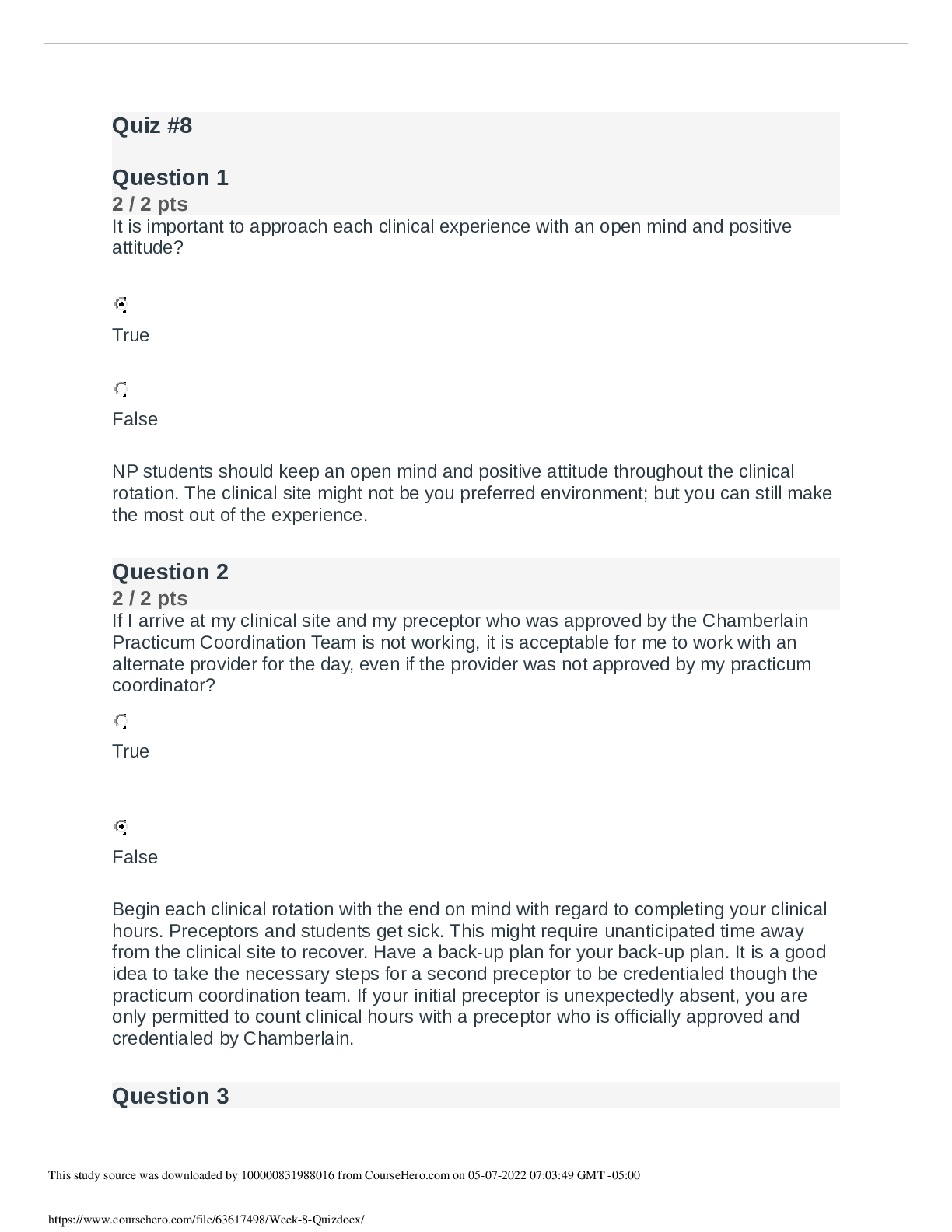


.png)
.png)
.png)
.png)

.png)


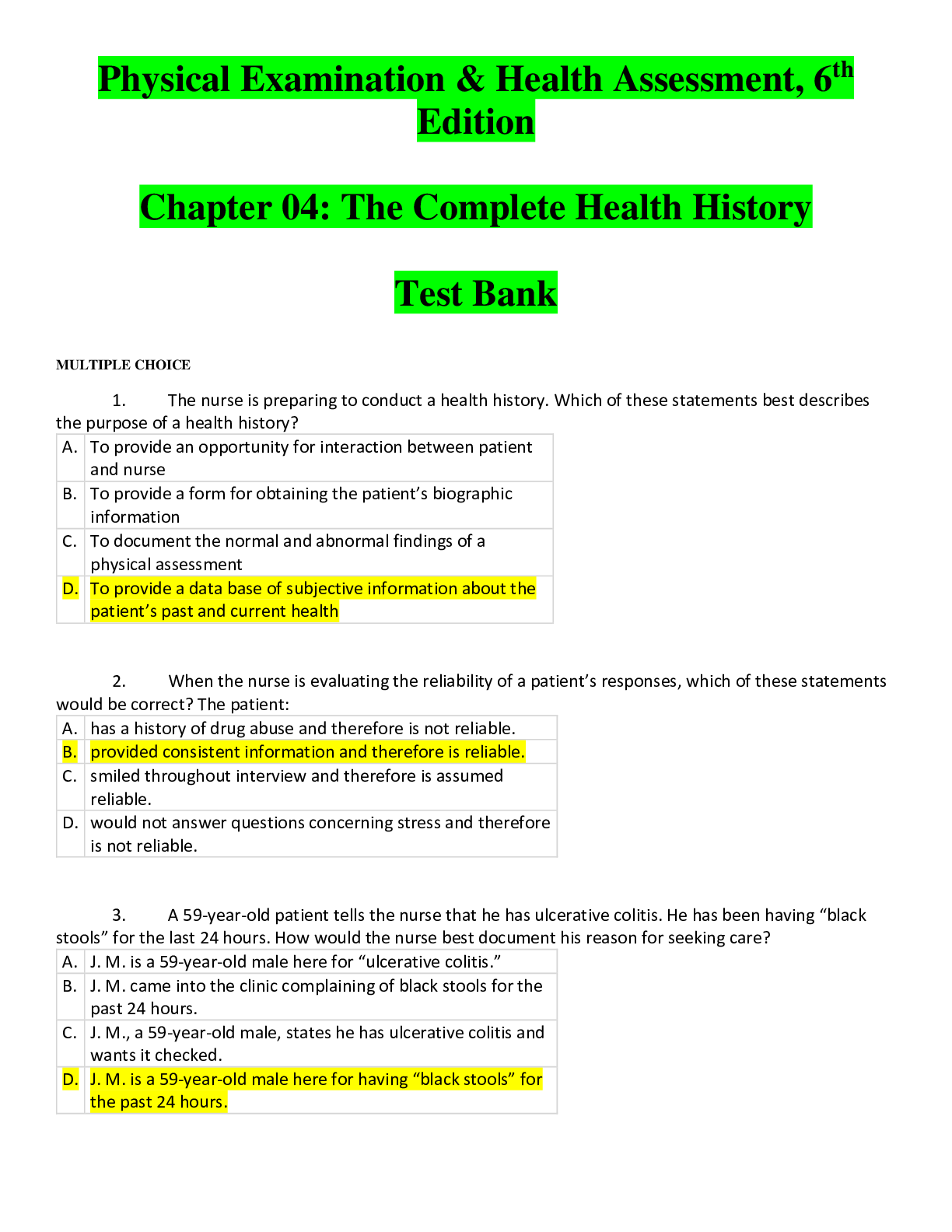
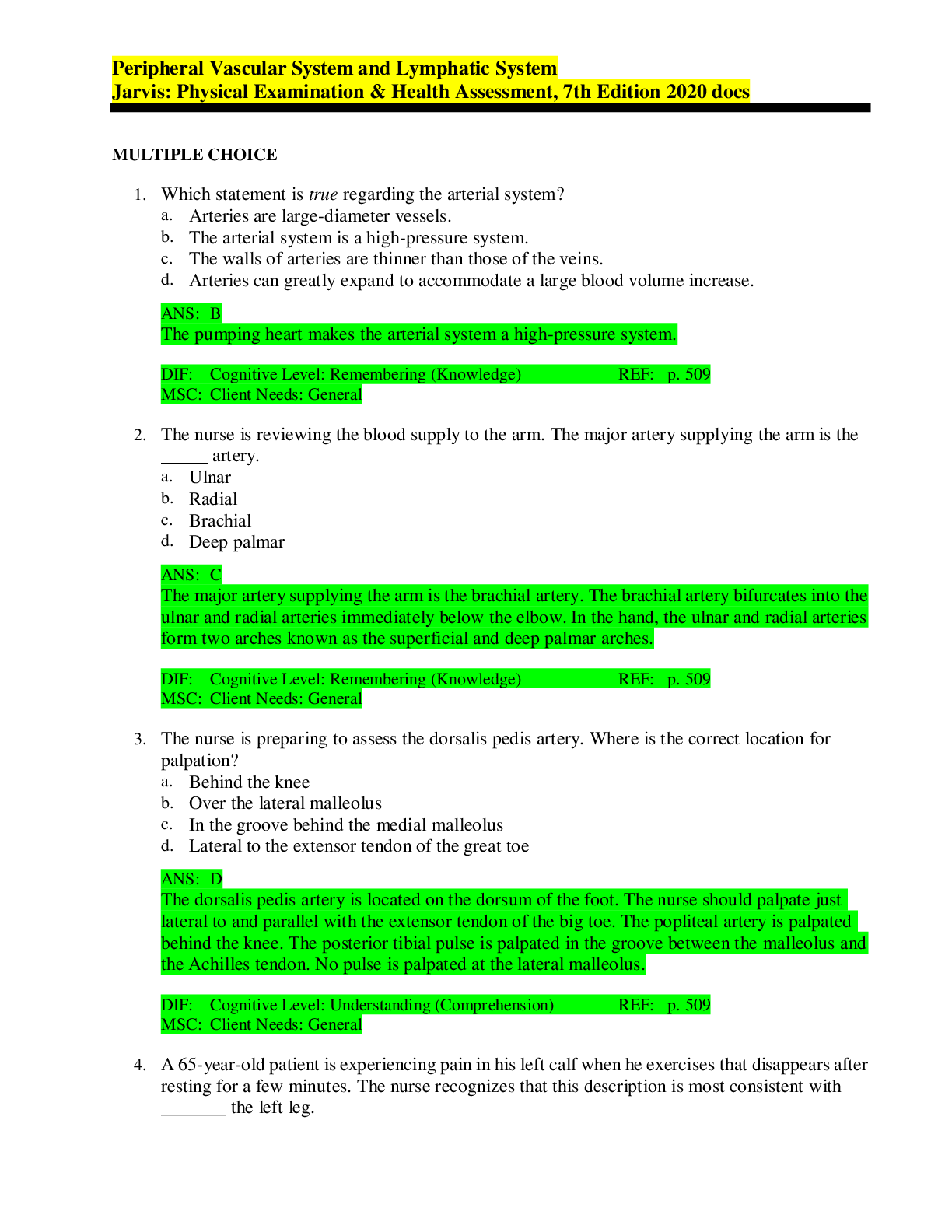
 answers.png)
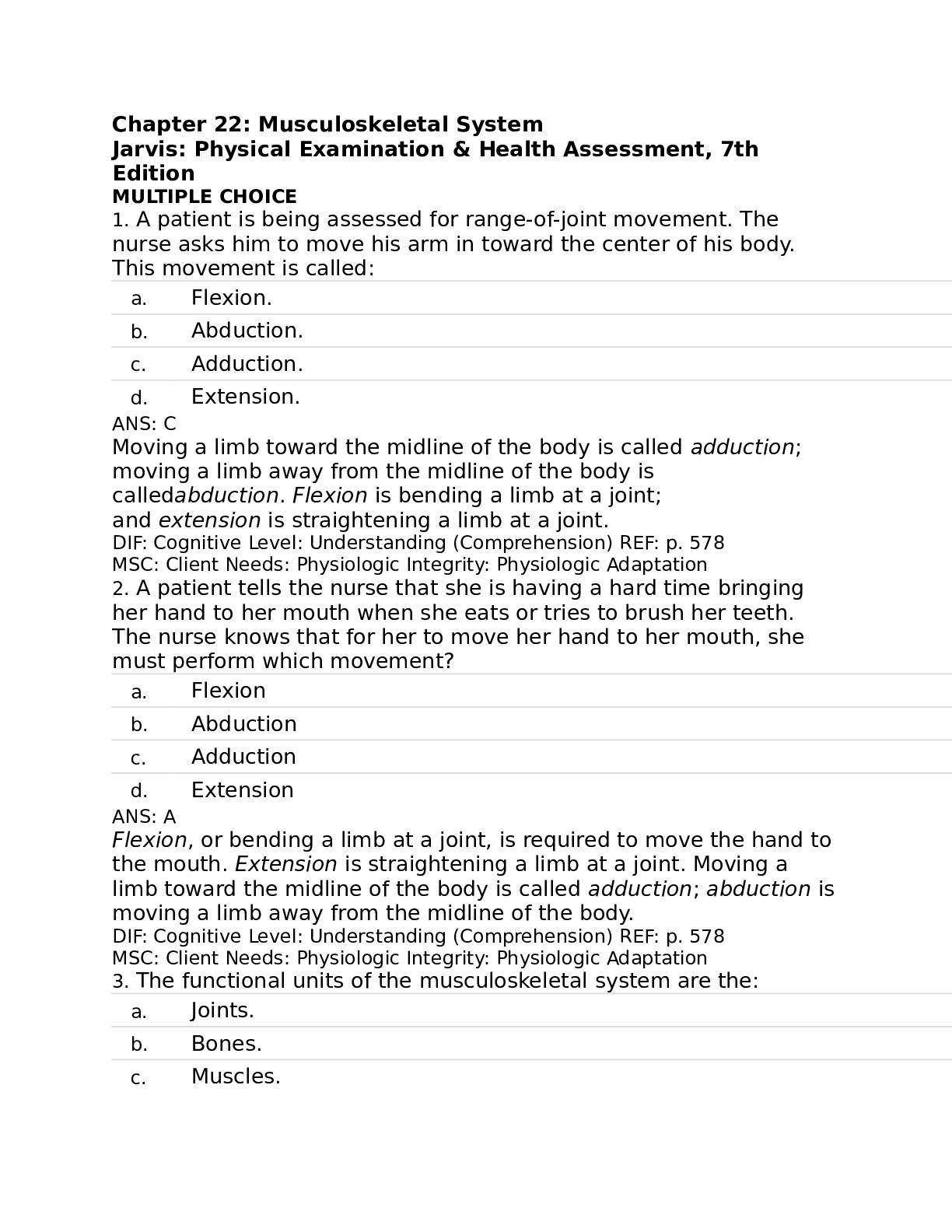
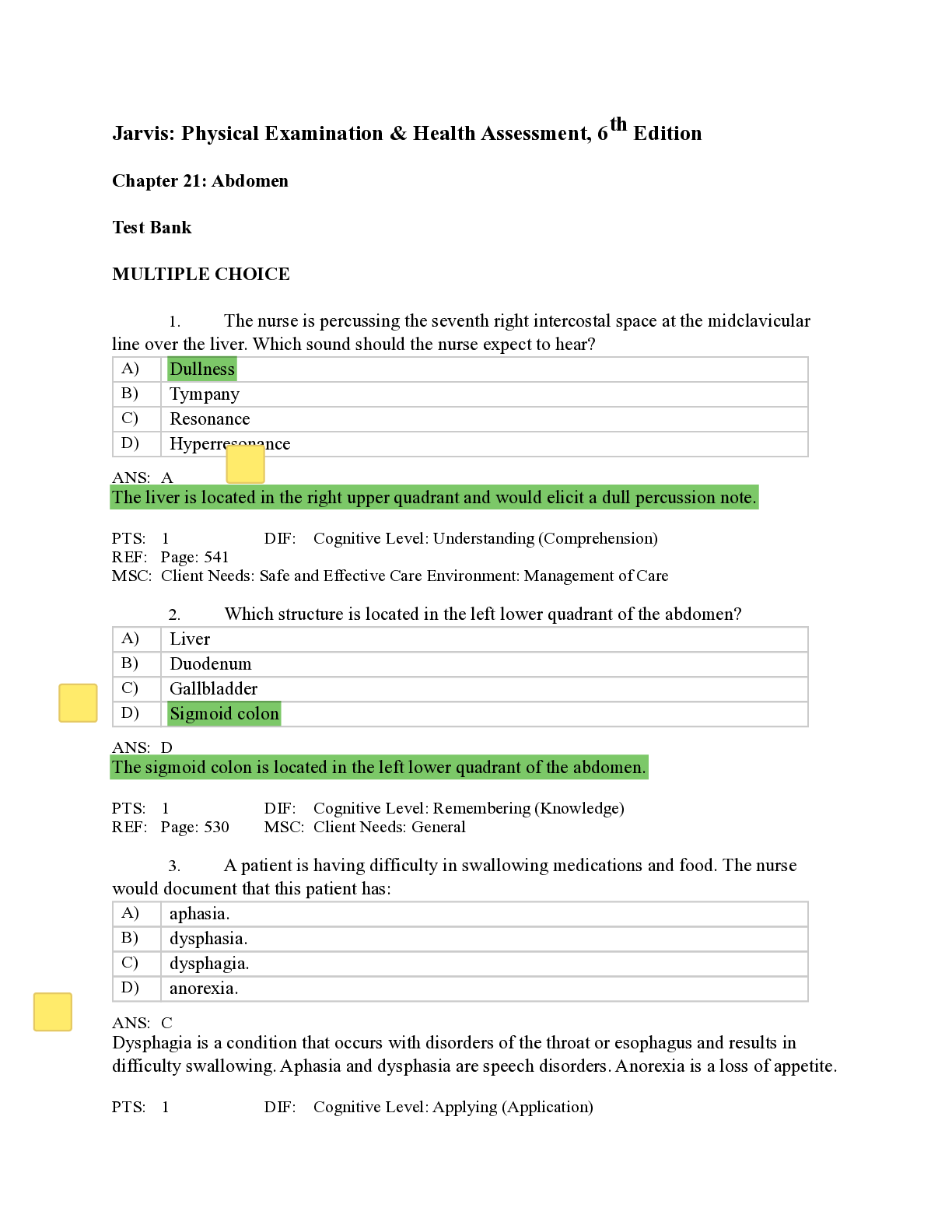
.png)
, Latest Questions and Answers with Explanations for Revision, All C.png)
, Latest Questions and Answers with Explanations for Revision, All Correct Latest Review, (La.png)
, Latest Questions and Answers with Explanations for Revision, All Correct Latest Review, (Latest 2021) Correc.png)
, Latest Questions and Answers with Explanations for Revision, All Correct Latest Revie.png)

